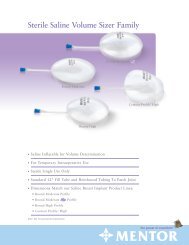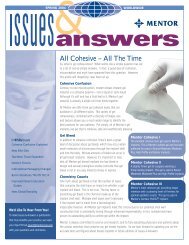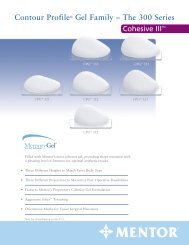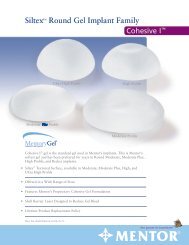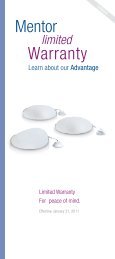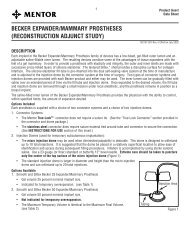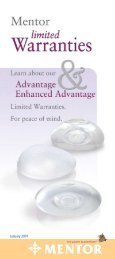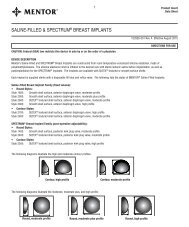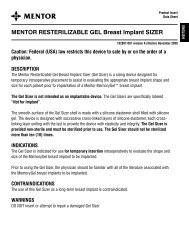Breast Reconstruction Patients Educational Brochure - Mentor
Breast Reconstruction Patients Educational Brochure - Mentor
Breast Reconstruction Patients Educational Brochure - Mentor
- No tags were found...
Create successful ePaper yourself
Turn your PDF publications into a flip-book with our unique Google optimized e-Paper software.
What to do if the Implant Rupture is ConfirmedIf your doctor confirms that you have a ruptured implant or that silicone gel has bled(moved) out of your implant shell, he or she will talk with you about your options. As aprecaution, <strong>Mentor</strong> recommends that ruptured implants be taken out permanently andeither replaced with a new implant or not replaced, depending on your preference ormedical need.45If your implant is taken out, your surgeon may also have to remove some of your breasttissue (the tissue capsule that forms around the breast implant), which will involveadditional surgery, with associated risks and costs. In some cases, it may not be possibleto replace your implants.8. MENTOR’S CLINICAL STUDY RESULTSAs part of the marketing approval requirements for the MemoryShape <strong>Breast</strong> Implant, <strong>Mentor</strong>conducted the MemoryShape <strong>Breast</strong> Implant Core Study with patients who received theimplants for augmentation (primary and revision) and reconstruction (primary and revision). Theresults of the study will provide you with useful information on the experience of other womenwho have received MemoryShape <strong>Breast</strong> Implants. The results of the MemoryShape <strong>Breast</strong>Implant Core Study should not be used to predict your own experience with the MemoryShape <strong>Breast</strong> Implant, but the information can be used as a general guide about what you may expect.Your own benefits and complications depend on many individual factors.8.1 Overview of the StudyThe MemoryShape <strong>Breast</strong> Implant Core Study is a prospective, 10-year, multicenterclinical study conducted to examine the safety and effectiveness of the MENTOR ®MemoryShape <strong>Breast</strong> Implants in patients undergoing primary augmentation, primaryreconstruction, revision-augmentation, and revision-reconstruction of the breast.There are 955 patients participating in the MemoryShape <strong>Breast</strong> Implant Core Study. Atotal of 572 patients had primary augmentation, 124 patients had revision-augmentation,191 patients had primary reconstruction, and 68 patients had revision-reconstruction. Ofthese patients, 252 primary augmentation patients, 56 revision-augmentation patients, 74primary reconstruction patients and 37 revision-reconstruction patients are assessed forimplant rupture for MRI at years 1, 2, 4, 6, 8, and 10 after receiving implants.Assessment of the safety of the MemoryShape <strong>Breast</strong> Implants is based on the incidenceof complications, including device failures. Effectiveness was assessed based on changesin bra size, chest circumference, patient satisfaction and measures of quality of life. Severalscales and questionnaires about these topics were used to collect information for analysis,including a global satisfaction question, the Rosenberg Self-Esteem Scale, the Body EsteemScale, the Short Form Health Survey (SF-36), and the <strong>Breast</strong> Evaluation Questionnaire.The Study will continue to follow patients through 10 years after their breast implantsurgery. Results provided here represent the first 6 years of data. This brochure will beupdated as more information becomes available. You should also ask your surgeon if he orshe has received any updated clinical information.The following sections provide more information about the complications and benefits youmay experience following reconstruction with MENTOR ® MemoryShape <strong>Breast</strong> Implants,based on the experiences of the reconstruction patients in the MemoryShape <strong>Breast</strong>Implant Core Study.8.2 What are the 3-Year and 6-Year Follow-up Rates?The study enrolled 191 primary reconstruction patients and 124 revision-reconstructionpatients. At the 3-year follow-up visit, data are reported for 93% of the eligible primaryreconstruction patients and 91% of the eligible revision-reconstruction patients. At the6-year follow-up visit, data are reported for 73% of the eligible primary reconstructionpatients and 76% of the eligible revision-reconstruction patients.





